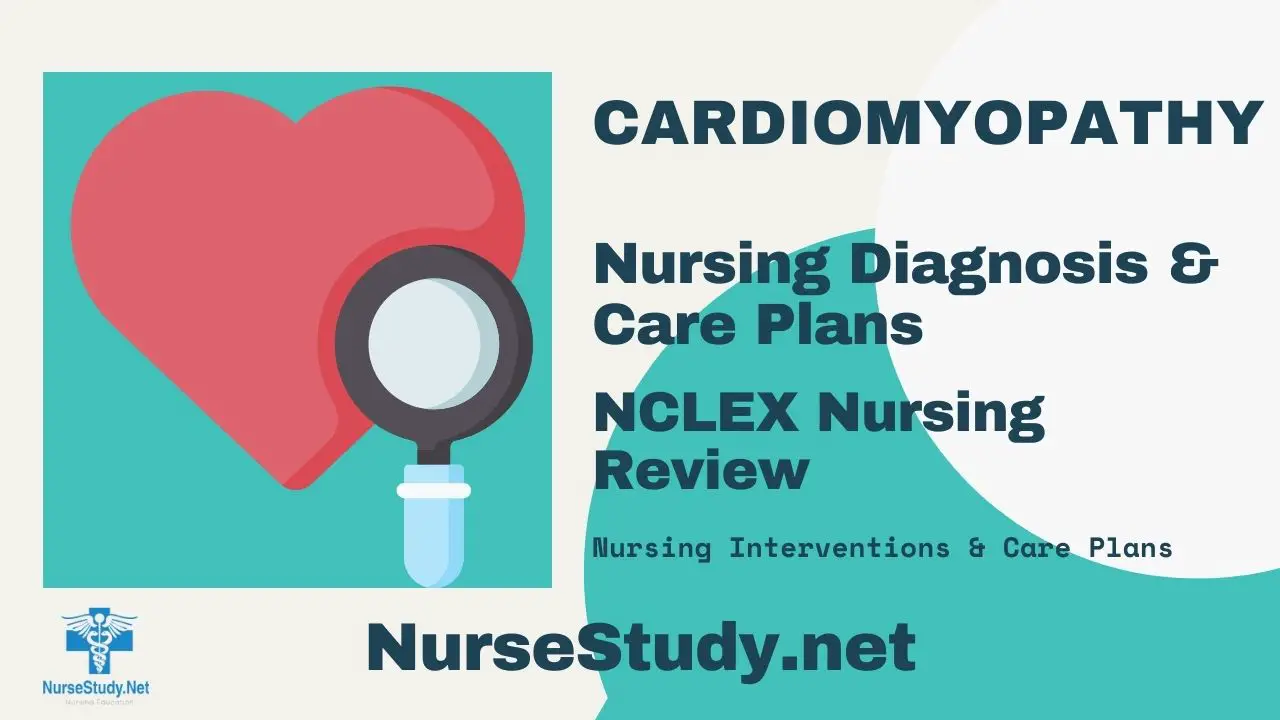Cardiomyopathy encompasses several conditions that affect the heart muscle’s structure and function. The condition can develop at any age and may be inherited or acquired. Understanding the different types helps nurses provide targeted care:
Types of Cardiomyopathy
Dilated Cardiomyopathy (DCM)
- Most common type
- Features enlarged heart chambers and impaired contraction
- Often leads to heart failure
- Common causes include genetics, infections, and toxins
Hypertrophic Cardiomyopathy (HCM)
- Characterized by thickened heart walls
- May cause dangerous arrhythmias
- Often genetic in origin
- Leading cause of sudden cardiac death in young athletes
Restrictive Cardiomyopathy (RCM)
- Least common type
- Rigid heart walls restrict filling
- Often related to other conditions like amyloidosis
- Poor prognosis without intervention
Nursing Care Plans for Cardiomyopathy
Nursing Care Plan 1. Decreased Cardiac Output
Nursing Diagnosis Statement:
Decreased cardiac output related to impaired myocardial contractility as evidenced by fatigue, dyspnea, and reduced ejection fraction.
Related Factors:
- Altered contractility
- Structural changes in heart muscle
- Arrhythmias
- Fluid volume overload
Nursing Interventions and Rationales:
Monitor vital signs and hemodynamics hourly
- Rationale: Early detection of deterioration enables prompt intervention
Assess for signs of heart failure
- Rationale: Cardiomyopathy often progresses to heart failure
Administer prescribed medications
- Rationale: Proper medication management improves cardiac function
Position patient to optimize cardiac function
- Rationale: Proper positioning reduces cardiac workload
Desired Outcomes:
- Maintained blood pressure within normal limits
- Improved exercise tolerance
- Reduced symptoms of heart failure
- Stable cardiac rhythm
Nursing Care Plan 2. Activity Intolerance
Nursing Diagnosis Statement:
Activity intolerance related to imbalance between oxygen supply and demand as evidenced by excessive fatigue and dyspnea with minimal exertion.
Related Factors:
- Decreased cardiac output
- Reduced oxygen delivery
- Muscle weakness
- Fatigue
Nursing Interventions and Rationales:
Implement a graduated activity program
- Rationale: Progressive activity building prevents overexertion
Monitor vital signs during activity
- Rationale: Ensures safe activity levels
Teach energy conservation techniques
- Rationale: Helps patient manage daily activities
Schedule rest periods between activities
- Rationale: Prevents excessive fatigue
Desired Outcomes:
- Improved activity tolerance
- Participation in daily activities without excessive fatigue
- Understanding of activity limitations
- Proper use of energy conservation techniques
Nursing Care Plan 3. Risk for Impaired Gas Exchange
Nursing Diagnosis Statement:
Risk for impaired gas exchange related to altered blood flow and ventilation-perfusion imbalance.
Related Factors:
- Decreased cardiac output
- Pulmonary congestion
- Altered breathing pattern
- Reduced oxygen delivery
Nursing Interventions and Rationales:
Monitor oxygen saturation continuously
- Rationale: Ensures adequate oxygenation
Position for optimal breathing
- Rationale: Improves ventilation
Administer oxygen as prescribed
- Rationale: Maintains adequate oxygenation
Assess breathing patterns
- Rationale: Early detection of respiratory compromise
Desired Outcomes:
- Maintained oxygen saturation >95%
- Normal breathing pattern
- Clear lung sounds
- No signs of respiratory distress
Nursing Care Plan 4. Risk for Fluid Volume Excess
Nursing Diagnosis Statement:
Risk for fluid volume excess related to compromised regulatory mechanisms and decreased cardiac output.
Related Factors:
- Impaired cardiac function
- Decreased renal perfusion
- Sodium and water retention
- Medication side effects
Nursing Interventions and Rationales:
Monitor daily weights and intake/output
- Rationale: Early detection of fluid retention
Assess for edema
- Rationale: Indicates fluid overload
Administer diuretics as prescribed
- Rationale: Manages fluid balance
Implement fluid restrictions as ordered
- Rationale: Prevents fluid overload
Desired Outcomes:
- Stable daily weight
- Balanced intake and output
- Minimal edema
- Effective response to diuretics
Nursing Care Plan 5. Anxiety
Nursing Diagnosis Statement:
Anxiety related to the change in health status and fear of complications as evidenced by expressed concerns and increased tension.
Related Factors:
- Threat to current health status
- Fear of death
- Changes in lifestyle
- Treatment uncertainties
Nursing Interventions and Rationales:
Provide clear information about the condition
- Rationale: Knowledge reduces anxiety
Teach coping strategies
- Rationale: Improves emotional management
Include family in care planning
- Rationale: Enhances support system
Refer to support groups
- Rationale: Provides additional resources
Desired Outcomes:
- Reduced anxiety levels
- Improved coping mechanisms
- Verbalized understanding of the condition
- Effective use of support systems
Patient Education and Discharge Planning
Effective patient education is crucial for managing cardiomyopathy. Key topics include:
- Medication management
- Activity modifications
- Diet restrictions
- Warning signs requiring medical attention
- Follow-up care schedule
References
- Huang X. Individual nursing promotes rehabilitation of patients with acute myocardial infarction complicated with arrhythmia. Am J Transl Res. 2021 Aug 15;13(8):9306-9314. PMID: 34540047; PMCID: PMC8430166.
- Paul, Sara DNP, RN, FNP; Hice, Amber RN, PCCN, CMC. Role of the Acute Care Nurse in Managing Patients With Heart Failure Using Evidence-Based Care. Critical Care Nursing Quarterly 37(4):p 357-376, October/December 2014. | DOI: 10.1097/CNQ.0000000000000036
- Wang K, Xiao Y, Fu C. Stratified Nursing Based on ICNSS Score: Study on the Impact of Complications and Rehabilitation Effects in Patients with Acute Myocardial Infarction Complicated by Heart Failure. Altern Ther Health Med. 2024 Oct 15:AT10835. Epub ahead of print. PMID: 39404614.
- Zhou Y, Wang X, Lan S, Zhang L, Niu G, Zhang G. Application of evidence-based nursing in patients with acute myocardial infarction complicated with heart failure. Am J Transl Res. 2021 May 15;13(5):5641-5646. PMID: 34150170; PMCID: PMC8205824.
